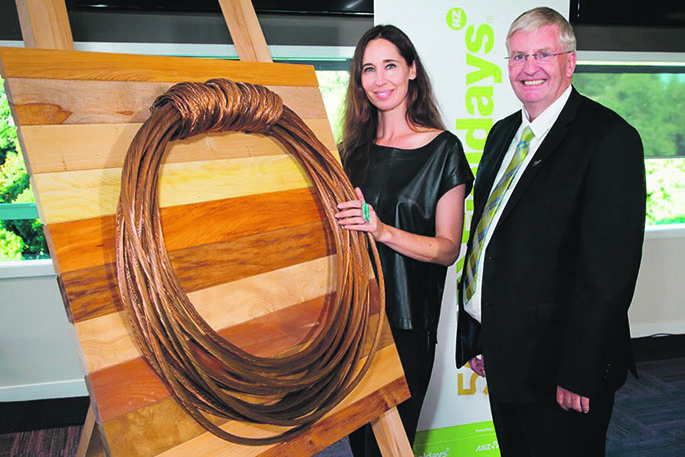In 1969 The Town and Country Fair, held at Hamilton’s Te Rapa Racecourse, aimed to bring rural and urban audiences together to celebrate New Zealand’s farming industry and lifestyle and the contribution it makes to the economy. Fast forward 50 years, the New Zealand Agricultural Fieldays – as it now called – is a staple on many agricultural people’s calendars, with hundreds of thousands descending on Mystery Creek each June. Celebrates of its 50th year of showcasing agriculture and innovation to rural and urban audiences alike have already kicked off. At the event’s first home, Te Rapa Racecourse, local politicians and district mayors, agricultural leaders, past and present presidents and members of the New Zealand National Fieldays Society, Waikato Racing Club members and other VIP guests gathered on February 15 to relive the early days with speeches and anecdotes, and the unveiling of a specially-commissioned anniversary sculpture. The racecourse housed Fieldays in its first two years before the event was moved to its current location at Mystery Creek in 1971. Many who attended this event were responsible for organising the inaugural Fieldays in 1969, including John Kneebone, who first sparked the idea for a town and country fair in New Zealand on a trip to the United Kingdom as a Nuffield scholar. The first one Speaking at the event to a backdrop of photos and film of Fieldays throughout the decades, New Zealand National Fieldays Society CEO Peter Nation thanked the Waikato Racing Club for its collaboration in the early days and the sacrifices they made to help pull it off. “The organisers at that first event in 1969 thought they’d have a couple thousand people turn up. But on the day, it turned out to be more than 10,000 with cars parked all the way up Te Rapa Straight, which was farmland back then,” says Peter. “I can only imagine the state of the racecourse after the first day with all those people trampling across it. We’re very grateful for that early relationship with the racing club, a relationship we’re still proud to have.” He gave thanks to the original six farmers of the Fieldays Society, whose tenacity and perseverance he said paved the way for Fieldays to become the premiere agricultural showcase it is today, contributing half a billion dollars to the global economy each year. “Those first six farmers approached ANZ in North Hamilton for a 100 per cent loan of $62,500 – which is $430,000 in today’s money – so they could move Fieldays to Mystery Creek. At the time, Mystery Creek was a run-down dairy farm but had been identified as the site to house the event for future growth. “The story goes that when the society went into the bank they were asked what security they had for the loan, and one of the farmers threw a roll of copper wire on the bank manager’s desk and said: ‘This is the only asset we own’.” That wire had been used for communication at Fieldays over the loudspeakers at Te Rapa Racecourse, where it was removed each year and put into storage for safekeeping. A copper wire tribute At the February get-together a 50th anniversary sculpture was unveiled, entitled Origin ‘68, which incorporates the same copper wire that was thrown on that bank manager’s desk decades ago, mounted on the reclaimed native timber that once lined the Fieldays Society’s original boardroom. “The copper in the sculpture is very important,” says Peter. “It’s not only a valued commodity, but it signifies communication and the transfer of information, and relationships and collaboration. “It also speaks to that No.8 wire mentality, that Kiwi way of just getting it done.” Peter says it’s important the sculpture be for everyone to enjoy “because Fieldays isn’t just an event for farmers and the agricultural industry – it’s a chance for everyone to get together and celebrate agriculture as a fantastic, integral part of New Zealand’s lifestyle and economy”. Auckland-based sculptor and jewellery designer Cherise Thomson was delighted to work on a sculpture of such significance. “It was such an honour to be chosen,” says Cherise. She placed second in Fieldays’ No.8 Wire National Art Awards in 2016 with her wire sculpture Korowai, and was a finalist again in 2017. Cherise says the 12 copper loops framed with native timber is a tribute to the seasonal life of farming, and the dedication of Fieldays’ volunteers and staff. “I wanted the sculpture to represent the cycle of interconnectedness, inspiration and growth that has made Fieldays what it is from the founders’ original vision 50 years ago.” Origin ’68 will be at Waikato Museum as part of the 50th anniversary Fieldays exhibition in May. February’s event is one of many planned to celebrate Fieldays’ anniversary in the lead up to 13 June, when the 50th event kicks off at Mystery Creek. This year’s theme is the ‘future of farming’, with visitors and exhibitors being encouraged to start discussions around what the future of farming means to them. For more information visit: fieldays.co.nz
Friday, April 19, 2024
Posted: 10:56am Thursday 05 Apr, 2018
From copper wire at the racecourse to NZ’s big ag event

Artist Cherise Thomson and New Zealand National Fieldays Society chief executive Peter Nation.


0 Comments
Leave a Comment